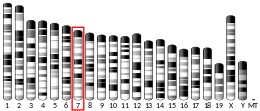PRMT1
Protein-coding gene in the species Homo sapiens From Wikipedia, the free encyclopedia
Protein arginine N-methyltransferase 1 is an enzyme that in humans is encoded by the PRMT1 gene.[5] The HRMT1L2 gene encodes a protein arginine methyltransferase that functions as a histone methyltransferase specific for histone H4.[6]
Function
PRMT1 gene encodes for the protein arginine methyltransferase that functions as a histone methyltransferase specific for histone H4 in eukaryotic cells.[6] Specifically altering histone H4 in eukaryotes gives it the ability to remodel chromatin acting as a post-translational modifier.[7]
Through regulation of gene expression, arginine methyltransferases control the cell cycle and death of eukaryotic cells.[7]
Reaction pathway
While all PRMT enzymes catalyze the methylation of arginine residues in proteins, PRMT1 is unique in that is catalyzes the formation of asymmetric dimethylarginine as opposed to the PRMT2 that catalyzes the formation of symmetrically dimethylated arginine.[8] Individual PRMT utilize S-adenosyl-L-methionine (SAM) as the methyl donor and catalyze methyl group transfer to the ω-nitrogen of an arginine residue.[8]
Clinical significance
In humans, these enzymes regulate gene expression and hence are involved in pathogenesis of many human diseases.[9] Using enzyme inhibitors for arginine methyltransferase 1, studies were able to demonstrate the enzyme's potential as an early catalyst of various cancers.[9][8][10]
Interactions
PRMT1 has been shown to interact with:
References
Further reading
External links
Wikiwand - on
Seamless Wikipedia browsing. On steroids.






